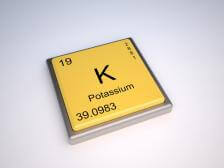A Tour of the Periodic Table (Part 2)
Continuing the tour of the periodic table of the elements, Ask Science looks at elemental groups and what they mean.
Lee Falin, PhD
Listen
A Tour of the Periodic Table (Part 2)

by Lee Falin, PhD
In Part 1 of this series on the periodic table, we looked at the information contained in each block of the periodic table of the elements. These included things like the atomic number, chemical symbol, and atomic weight of each element. I also mentioned that these blocks of elemental information are arranged in columns called groups and rows called periods. Today we’re going to look closer at what we can learn from the groups or columns that each element belongs to.
These days, each column of the periodic table is numbered, from 1 to 18. There used to be a couple of other popular labeling systems, but they are gradually fading from use, so we’ll ignore them in the hopes that we can contribute to their timely demise.
The elements within each group tend to share similar physical and chemical properties. The latter of which is most heavily influenced by the fact that they have the same number of valence electrons. (If you don’t remember what a valence electron is, take a look at my episode on Atomic Bonds.
It would take a lot more time than any of us want to spend to explain the qualities of every elemental group, so today we’ll just hit a few of the exciting ones.
Elemental Groupies
The first group of elements, usually called the “alkali earth metals,” lives in the first column of the periodic table. This group consists of lithium, sodium, potassium, and few other “-um’s.” These metals tend to be soft and shiny. They also react strongly with water, where the meaning of “react strongly” can range from causing extreme aquatic turbulence to causing a powerful explosion.
The second group of elements, the “alkaline earth metals,” consists of silvery white metals such as beryllium, calcium, barium, radium, and a few others. While they share some physical and chemical properties, the applications of these elements are rather diverse, resulting in such things as emeralds (from beryllium), Flinstone’s vitamins (from calcium), green fireworks (from barium), and glow in the dark watch hands (from radium). Just one bit of good news, in case you were wondering: watch-makers stopped using radium in glow in the dark paint once someone realized that having a radioactive watch wasn’t the best idea for our health. Go figure!
See also: What is Radiation?
The next group we’ll look at today is the 17th group in the table, usually called the halogens. This group consists of fluorine, chlorine, bromine, iodine, and a couple other “-ine’s.” Halogens tend to be extremely reactive elements, making them particularly dangerous to humans. Fluorine, for example, is highly toxic in even small amounts.
However, their high-reactivity also gives them some very useful properties. Fluorine is used to make Teflon, chlorine is an important sterilization agent and is also used to make bleach. Many plastics are also made from elements in the halogen group. You probably won’t be surprised to know that halogen light bulbs are also made using halogens.
The final elemental group we’ll discuss today is the noble gas group. The noble gas group consists of a very useful set of well-known elements – helium, neon, argon, krypton, neon – as well as the considerably less useful radon. All of these aristocratic elements are colorless, odorless gasses at room temperature. Since these elements have a full shell of valence electrons, they have the handy property of typically not reacting with anything. Most people are familiar with noble gasses through their use in neon lights, though not all lights that we call “neon lights” actually use neon, some use other noble gasses to achieve different colors. Aside from its lighting capabilities, helium is also widely used to inflate balloons, both the kind you get at birthday parties and the kind used to lift weather instruments and world record-breaking skydivers into the stratosphere.
Won’t Someone Think of the Hydrogen?

Also, since hydrogen’s valence shell can only hold two electrons, you could think of it as missing one electron for a full shell, which is the same situation the halogens are in. Unfortunately, it doesn’t precisely match up with the halogens either, so it’s a bit of an elemental outcast.
Conclusion
That’s all of the groups we have time to cover today. If you’ve got a favorite elemental group that we didn’t cover today, leave a note in the comments with the details or post it on the Ask Science Facebook page.
If you liked today’s episode, you can subscribe to the Ask Science podcast on iTunes or follow me on Twitter. If you have a question that you’d like to see on a future episode, send me an email at everydayeinstein@quickanddirtytips.com.
Potassium,Lightbulb and Hydrogen Atom images courtesy of Shutterstock

